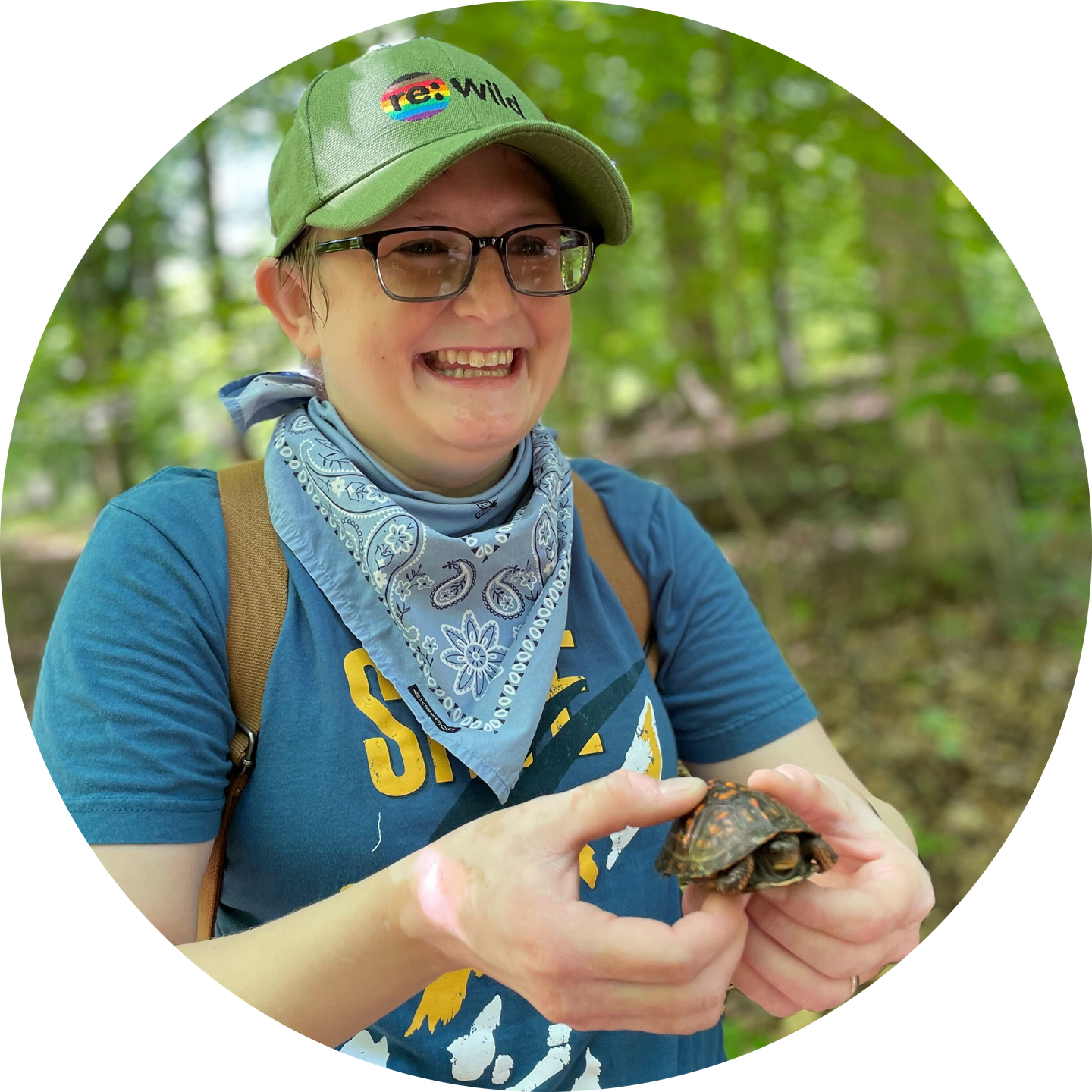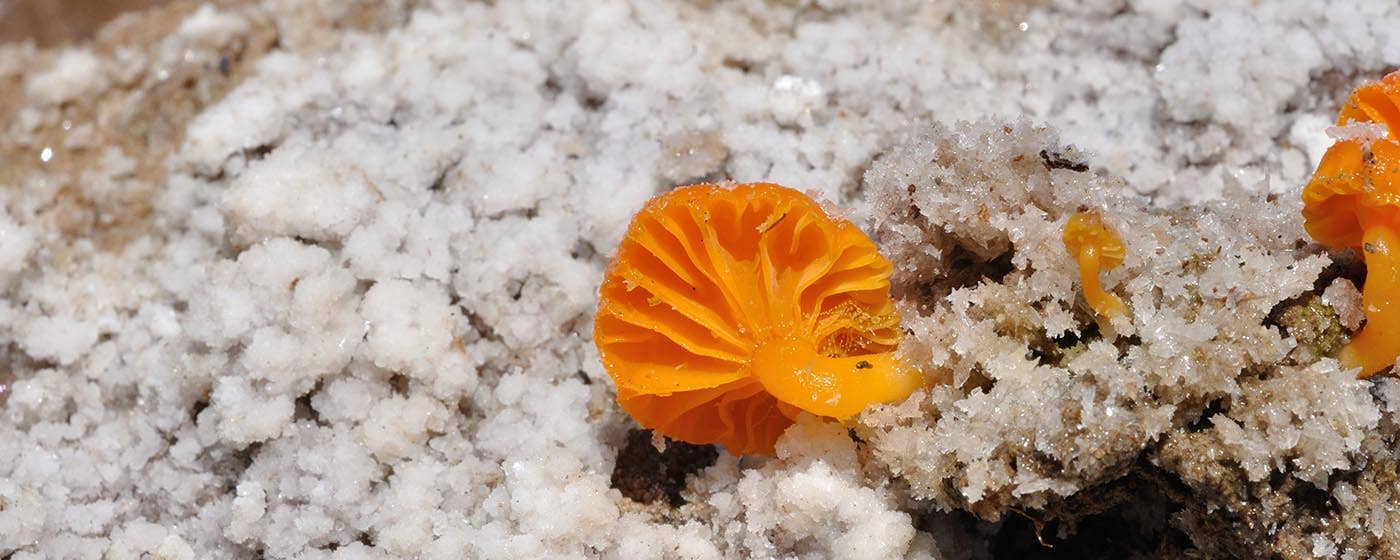Kingdom Fungi is full of fascinating and dramatic stories of life and death, coevolution, symbiosis and discovery. Each year up to 2,000 new species are discovered globally, some by trained scientists, others by lovers of nature and mushrooms, and still others by individuals who have no idea what they’ve come across. Mycologists estimate that there are somewhere between 2.2 and 3.8 million species of fungi on Earth, but so far only 8% of these species have been documented scientifically. That means there’s a whole wild world of fungi still out there to be found.
We wanted to know the top 10 most exciting recent fungi discoveries, so we turned to our favorite resource: our friends at the Fungi Foundation. They helped us compile this list, which is just the tip of the iceberg (yes, some fungi can even live in ice!) as far as fascinating fungi facts go.
Want to find a species of your own? Many species are out there hiding in plain sight. Check out the Fungi Foundation’s What You See Matters campaign, which includes a scientific collection standard and instructions for how you can correctly preserve and submit fungi species you find on your hikes and other wild excursions.
Friends with benefits
Common name: N/A
Scientific name: Cortinarius galbus
Discovered: 2021
Cortinarius may be the most diverse and abundant genus of the kind of fungi that have a symbiotic relationship with plant roots: the fungi provide the plants with water and help them absorb nutrients, while the plant gives the fungus carbohydrates. Although this is the role of Cortinarius galbus, this recently discovered species is still its own special little weirdo. Found in the Southern Andean Mountains in Chile and Argentina, this strange yellow truffle lives buried in the soil in the southern Andean forests and has a cup-like structure (called a volva) that never grows out of an immature stage. It also has long spores--longer than any in the genus--with unusual rounded knobs at the ends.
Truffles without borders
Common name: N/A
Scientific name: Amanita nouhrae
Discovered: 2015
Truffles of the Amanita variety were known only from Australia...until 2015 when mycologists confirmed Amanita nouhrae in Andean Patagonia, surprising the scientific community and reminding the world of this kingdom’s incredible diversity. The Amanita genus, which includes some of the most toxic known mushrooms in the world, itself keeps scientists on their toes. Although most of these species live in the northern hemisphere, the species in the southern hemisphere evolve into truffles (a fruiting body, like a mushroom, that grows underground) and nobody is sure why. A. nouhrae is found only from three localities and probably includes only about 600 mature individuals, making it likely very rare. It also has unique ornamented spores resembling golf balls, which is rare in the genus.
Gone rogue
Common name: Rogue Mushroom
Scientific name: Psathyrella aquatica
Discovered: 2005
Described: 2010
The Rogue Mushroom (Psathyrella aquatica) is the first-ever known mushroom species to live and reproduce underwater. And...it has gills! It is the only aquatic gilled fungus. Researchers from Southern Oregon University came across this mushroom by chance in the cold flowing water of Oregon’s Rogue River. Nobody is quite sure how the fungus disperses its spores and the biology of the species has spurred more questions so far than answers, including how this species is adapted to live underwater. Only two reproducing populations of the mushroom have been found, both near Crater Lake National Park.
Puff the magic mushroom
Common name: N/A
Scientific name: Bovista pezica
Discovered: 2020
Puffball fungi belong to the phylum called Basidiomycota, which also includes fungi with other such distinguished names as stinkhorns. Bovista pezica is a true puffball, which earned their name because of the puffs of spores they release. Bovista pezica was discovered in a dry steppe in southern Argentina and is unique for the branches on the smooth body of its fruit. This species might also transport its spores to distant locations by sending them floating on water streams, something mycologists had not previously observed. Fungi in the phylum Basidiomycota live in wood (either solid or decaying) in grasslands and forests.
Today’s special: Cicadas
Common name: N/A
Scientific Name: Ophiocordyceps araracuarensis
Described: 2015
This relatively new species from the Amazon is an entomopathogenic fungus, which means that it acts as a parasite that can take over the bodies of insects (think zombie ants!)--or kills them and devours them! O. aracuarensis prefers a specific Amazonian species of cicada for its unwitting victim. While the cicada certainly doesn’t get anything out of this relationship, entomopathogenic fungi are important natural regulators of insect and arachnid populations, according to the book “Microbial Control of Insect and Mite Pests.” The discovery of this species in particular is helping mycologists better understand the taxonomy of entomopathogenic fungi in the Amazon, where these species have been less studied.
Celestial mushrooms
Common name: N/A
Scientific name: Amanita galactica
Described: 2020
This mushroom species, discovered in 2014 but named in 2020, looks like a little slice of the cosmos on Earth. It’s related to Amanita muscaria, the well-known and toxic red-capped mushroom with white dots. But Amanita galactica has a slightly more gothic color palette, sporting a black cap with white dots. Giuliana Furci, Fungi Foundation CEO, discovered the species in the southern Andes in Chile, living at the base of Evergreen Southern Beech trees and Chilean Monkey Puzzle trees. The bright white spots on the black mushroom cap reminded her of a galaxy dotted with stars. It’s an ancient species and its evolution can be traced back more than 180 million years, before the continents that made up the landmass Gondwana drifted apart.
The spider spectacle
Common name: N/A
Scientific name: Cordyceps caloceroides
Described: 2002 / 1868
There are 400 species in the genus Cordyceps and they all live inside other animals or fungi, essentially turning them into zombie-like creatures. Cordyceps caloceroides, a species native to South America, specializes in parasitizing tarantulas. Its mycelium spreads through the spider’s body, destroying its tissues, until it dies and the fruiting bodies of the fungus sprout out of the spider’s body to produce spores.
A cartoon character mushroom
Common name: N/A
Scientific name: Spongiforma squarpantsii
Described: 2011
This mushroom is famous for its scientific name, which is essentially Latin for “SpongeBob SquarePants Mushroom.” With its orange color, fruity smell, and springy texture that almost seems to act like a sponge, Spongiforma squarpantsii does have a passing resemblance to the pineapple-dwelling Nickelodeon character. But that’s not where the similarities end, when scientists observed the mushroom under a microscope, the part of it that produces spores even looked like tube sponges covering the ocean floor.
Tiny mushroom trees
Common name: N/A
Scientific name: Podoserpula aliweni
Described: 2021
These whitish-yellow mushrooms look like tiny trees or pagodas, which is why the group of mushrooms it belongs to is called pagoda mushrooms. As Podoserpula aliweni grows it sprouts successive “hats,” with one growing on top of the other. It’s the first of the Podoserpula genus to be discovered in the Americas. Scientists are still learning about Podoserpula mushrooms and know little about them.
Some lichen it salty
Common name: N/A
Scientific name: Lichenompalina altoandina
Described: 2017
About 9,800 feet (3,000 meters) up in the Chiléan Andes is a very peculiar and incredibly rare fungus. It lives in salt flats and salt lakes, environments that would be too salty and harsh for most organisms. But Lichenompalina altoandina manages to keep hydrated with special adaptations to keep it from drying out. The salt isn’t the only harsh part of its high-altitude home, it also gets blasted by radiation from the sun. Its bright orange pigment and thick hyphal walls prevent it from getting burned by the sun and drying out. Lichenompalina altoandina plays host to a single-celled algae for food. It feeds off of the plant sugars the algae produces.

Devin Murphy
Writer
Devin Murphy is Re:wilds’s senior communications specialist and helps Re:wild and its partners tell stories about the work they do to protect wildlife and wildlands around the planet. Her favorite stories about conservation include fascinating and little-known species and the dedicated humans protecting them.




